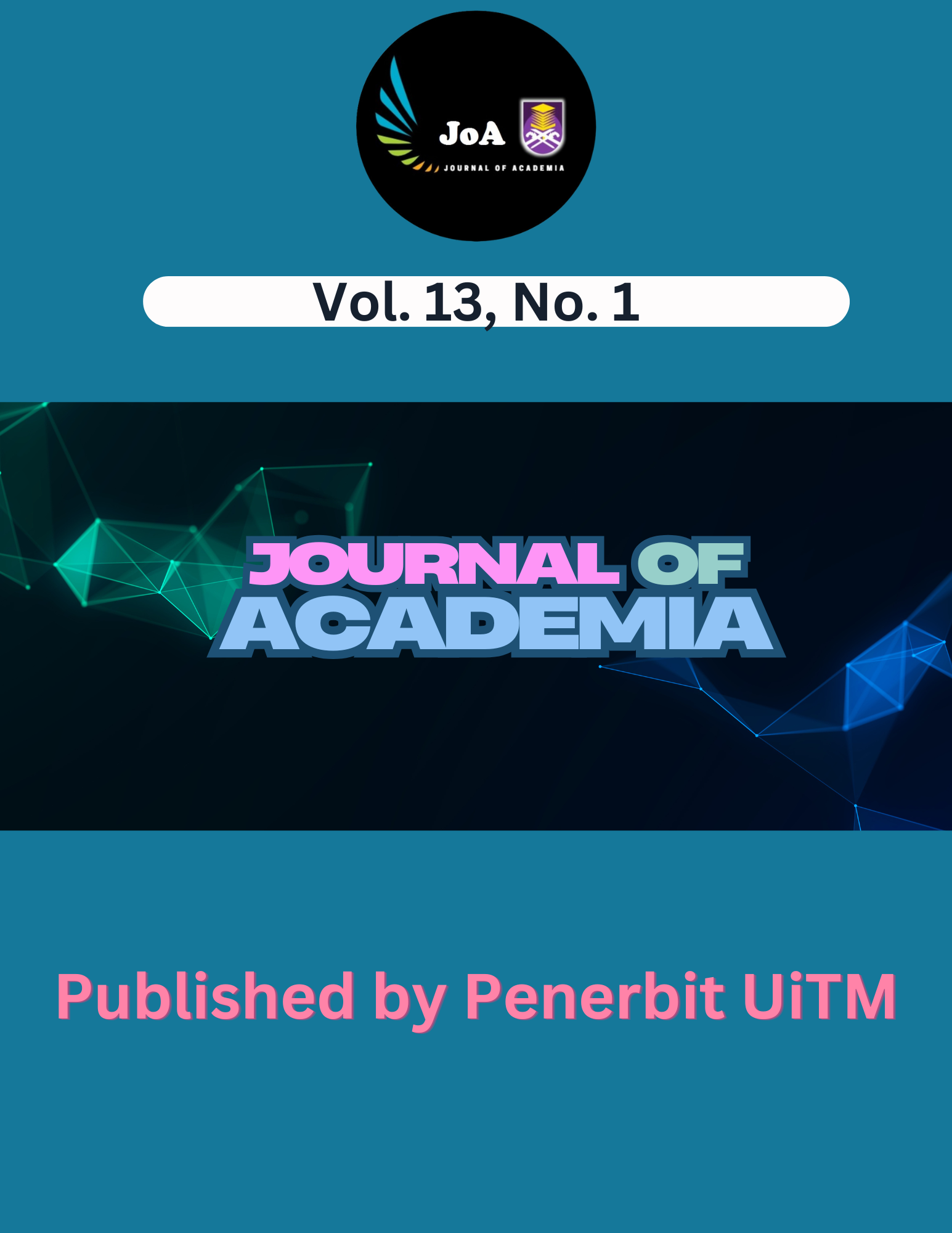THE COMPARISON OF DIVERSITY OF GRASS SPECIES AND ITS PHYSIOLOGICAL PERFORMANCE ON SELECTED SLOPE AND FLAT AREAS IN UiTM KUALA PILAH
DOI:
https://doi.org/10.24191/joa.v13i1.4552Keywords:
slope, diversity of plant species, plant physiology, relative chlorophyll, soil pHAbstract
Landslides are natural disasters that cause a lot of damage towards both human and biodiversity on earth. The damage is significant enough to deplete nature’s resources and claim human lives. Vegetation on slope play a crucial role in stabilizing them by strengthening the roots and influencing the saturated soil water cycle. The study investigates the morphology and physiological performance of different grass species in direct sunlight on selected slope and flat areas. Additionally, it compares the biodiversity of grass species between these two areas, providing insights into their adaptation and ecological roles. A comprehensive analysis of grass diversity and its physiology has been conducted. The diversity index of the data was analyzed using SPSS output to determine the diversity and evenness of the grass species. The data were collected from selected slope and flat areas in UiTM Kuala Pilah. A total of nine grass species from the Poaceae family were recorded in three plots on the slope and three plots on the flat area. The mean values of Shannon-Wiener diversity (H’) indices for six plots were recorded at slope area as 0.67 (Plot 1), 0.68 (Plot 2), 0.68 (Plot 3) and 0.37 (Plot 1), 0.76 (Plot 2) and 0.69 (Plot 3) at flat area. Mean of Pielou’s Evenness (J’) reveal a higher value at slope (0.97 for Plot 1, 0.98 for Plot 2 and 0.98 for Plot 3) compared to plat areas where the values were 0.53 (Plot 1), 0.68 (Plot 2) and 0.99 (Plot 3). The value of the relative chlorophyll content on the slope was highest in Sporobolus vaginiflorus with a reading of 40.1 ± 2.4a, and lowest in Heteropogon contortus with 23.2 ± 3.32b. On the flat area, Pennisetum clandestinum with 37.8 ± 0.79a as the highest and Paspalum vaginatum with 20.4 ± 6.26b as the lowest reading. The pH of the soils ranged from 3.99 ± 0.08b to 4.80a ± 0.04a in the sloping area, and from 5.83 ± 0.23a to 6.21 ± 0.30a in the flat area. The soil pH was measured to determine the stability of the slope, as it plays an important role in ensuring stability at different elevation. The relative chlorophyll content between different species of grass proving the physiological performance also contributes to maintaining the slope stability. The abundance of species diversity determines the overall diversity and ensures a balanced ecosystem.
References
Azmi N., M. N. (2010). Axonopus fissifolius. Retrieved from Malaysia Biodiversity Information System (MyBIS): https://www.mybis.gov.my/sp/13472
Babulal, V. (2021). 1,474 critical slopes identified in Peninsular Malaysia. New Straits Time. Retrieved November 20, 2022, from https://www.nst.com.my/news/nation/2021/11/743844/1474-critical-slopes-identified-peninsular-malaysia-nsttv
Bernama (Ed.). (2022). Nanta: Landslide in Kuala Pilah involves 30m stretch along Jalan Felda Kepis. The Star. https://www.thestar.com.my/news/nation/2022/12/18/nanta-landslide-in-kuala-pilah-involves-30m-stretch-along-jalan-felda-kepis#:~:text=SEREMBAN%3A%20The%20survey%20and%20visual,depth%20of%2010m%20of%20rubble. Accessed 11 May. 2023
Brown, L. (1979). Grasses: An Identification Guide. New York: Roger Tory Peterson Institute.
Caton B. P., Mortimer. M. (2004). A Practical Field Guide to Weeds of Rice in Asia. Makati City: International Rice Research Institute.
Fatima, S., Hameed, M., Ahmad, F., Ahmad, M. S. A., Khalil, S., Munir, M., Ashraf, M., Ahmad, I., Ahmad, K. S., & Kaleem, M. (2022). Structural and functional responses in widespread distribution of some dominant grasses along climatic elevation gradients. Flora: Morphology, Distribution, Functional Ecology of Plants, 289. https://doi.org/10.1016/j.flora.2022.152034
JKR (2009). National Slope Master Plan 2009-2023. Creative Thumbprint Sdn Bhd. https://jpedia.jkr.gov.my/images/d/d3/National_Slope_Master_Plan_2009-2020_-_Versi_English.pdf. Accessed 15 Feb. 2024.
JPS (2010). Guideline For Erosion And Sediment Control In Malaysia. Department of Irrigation and Drainage (DID). https://www.water.gov.my/jps/resources/auto%20download%20images/5844dff6dadd8.pdf. Accessed 15 Feb. 2024.
Lim, C., Mat Yunoh, S. M., & Kiew, R. (2009). Botany of the Berembun Forest Reserve, Negeri Sembilan, Malaysia. Malayan Nature Journal, 61(2), 143-189.
Liu, K., Liu, Z., Li, X., Shi, X. R., Lock, T. R., Kallenbach, R. L., & Yuan, Z. Y. (2022). Precipitation-mediated responses of plant biomass production and allocation to changing soil pH in semiarid grasslands. Agriculture, Ecosystems and Environment, 339. https://doi.org/10.1016/j.agee.2022.108123
Manidool, C. (1980). Paspalum conjugatum (PROSEA) - PlantUse English. https://uses.plantnet-project.org/en/Paspalum_conjugatum_(PROSEA). Accessed 11 Apr. 2023
Malik, A. A. (2021). LETTER | Deforestation that is taking place in Malaysia today. Malaysiakini. https://www.malaysiakini.com/letters/602049. Accessed 6 June. 2023
Marin, R. J., & Velásquez, M. F. (2020). Influence of hydraulic properties on physically modelling slope stability and the definition of rainfall thresholds for shallow landslides. Geomorphology, 351. https://doi.org/10.1016/j.geomorph.2019.106976
Marita I., G. K. (1999). Upland Rice Weeds of South and Southeast Asia. Makati City: International Rice Research Institute.
Md Roskan, N. F., Zainol, N., & Samad, K. A. (2022). Chlorophyll extraction from pineapple plantation waste through mechanical extraction. Biocatalysis and Agricultural Biotechnology, 39. https://doi.org/10.1016/j.bcab.2021.102264
Merino, A., Omil, B., Piñeiro, V., Barros, N., Souza-Alonso, P., & Campo, J. (2023). Soil C dynamics after deforestation and subsequent conversion of arable cropland to grassland in humid temperate areas. Science of the Total Environment, 901. https://doi.org/10.1016/j.scitotenv.2023.165793
Mengisu, S. D., Teketay, D., Demissew, S., Awas, T., & Kindu, M. (2022). Herbarium-based study of flowering and fruiting phenology of twelve indigenous and endemic plant species from Ethiopia. South African Journal of Botany, 150, 260–274. https://doi.org/10.1016/j.sajb.2022.07.026
Mishra, B., & Chandra, M. (2022). Evaluation of phytoremediation potential of aromatic plants: A systematic review. In Journal of Applied Research on Medicinal and Aromatic Plants (Vol. 31). Elsevier GmbH. https://doi.org/10.1016/j.jarmap.2022.100405
Noorasyikin, M. N., Zainab, M., Derahman, A., Md Dan, M. F., Madun, A., Md Yusof, Z., & Pakir, F. (2022). Mechanical properties of Bermuda grass roots towards sandy and clay soil for slope reinforcement. Physics and Chemistry of the Earth, 128. https://doi.org/10.1016/j.pce.2022.103261
O’Brien, D., Bohan, A., McHugh, N., & Shalloo, L. (2016). A life cycle assessment of the effect of intensification on the environmental impacts and resource use of grass-based sheep farming. Agricultural Systems, 148, 95–104. https://doi.org/10.1016/j.agsy.2016.07.004
Osman, N., Dorairaj, D., Halim, A., Abu Zelan, N. I., Abdul Rashid, M. A., & Zakaria, R. M. (2021). Dynamics of plant ecology and soil conservation: Implications for cut-slope protection. Acta Oecologica, 111. https://doi.org/10.1016/j.actao.2021.103744
Oregon State University. (2016, May 2). Tall Fescue Online Monograph. Forage Information System. https://forages.oregonstate.edu/tallfescuemonograph/figure/2-1
Ren, R., Wan, Z., Chen, H., & Zhang, Z. (2022). The effect of inter-varietal variation in sugar hydrolysis and transport on sugar content and photosynthesis in Vitis vinifera L. leaves. Plant Physiology and Biochemistry, 189, 1–13. https://doi.org/10.1016/j.plaphy.2022.07.031
Riveros, P. S. (1990). Tropical grasses. Rome: Food and Agriculture Organization of the United Nations.
Rodriguez, I. R., & Miller, G. L. (2000). The Soil-Plant Analyses Development (SPAD) unit of Minolta Camera Using a Chlorophyll Meter to Determine the Chlorophyll Concentration, Nitrogen Concentration, and Visual Quality of St. Augustinegrass. Hortscience (Vol. 35, Issue 4).
Rusli, L. S., Osman, N., Abdullah, R., Yaacob, J. S., & Seow, A. H. (2021). Effects of palm kernel biochar on the physiological responses and root profiles of sendudok (Melastoma malabathricum l.) grown on acidic soil. Applied Ecology and Environmental Research, 19(4), 2887–2903. https://doi.org/10.15666/aeer/1904_28872903
Saha, S., Bera, B., Shit, P. K., Sengupta, D., Bhattacharjee, S., Sengupta, N., Majumdar, P., & Adhikary, P. P. (2022). Modelling and predicting of landslide in Western Arunachal Himalaya, India. Geosystems and Geoenvironment, 100158. https://doi.org/10.1016/j.geogeo.2022.100158
Saifuddin, M., & Normaniza, O. (2016). Rooting Characteristics Of Some Tropical Plants For Slope Protection. Journal of Tropical Forest Science (Vol. 28, Issue 4).
Shah, A. (2022). Batang Kali landslide: Incident caused by underground water, says Public Works Dept. The Star Online. https://www.thestar.com.my/news/nation/2022/12/18/batang-kali-landslide-incident-caused-by-underground-water-says-public-works-dept. Accessed 14 Dec. 2022
Shah, C. R., Sathe, S. S., Bhagawati, P. B., & Mohite, S. S. (2021). A hill slope failure analysis: A case study of Malingoan village, Maharashtra, India. Geology, Ecology, and Landscapes, 5(1), 1–6. https://doi.org/10.1080/24749508.2019.1695714
Soa P. O., S. P. O. et al. (2016) ‘Digitaria ciliaris: Digitaria ciliaris PlantwisePlus Knowledge Bank. CABI International. doi: 10.1079/pwkb.20167800676.
Soreng, R. J., Peterson, P. M., Romaschenko, K., Davidse, G., Zuloaga, F. O., Judziewicz, E. J., Filgueiras, T. S., Davis, J. I., & Morrone, O. (2015). A worldwide phylogenetic classification of the Poaceae (Gramineae). In Journal of Systematics and Evolution (Vol. 53, Issue 2, pp. 117–137). Wiley-Liss Inc. https://doi.org/10.1111/jse.12150
Tikadar, K. K., Kunda, M., & Mazumder, S. K. (2021). Diversity of fishery resources and catch efficiency of fishing gears in Gorai River, Bangladesh. Heliyon, 7(12). https://doi.org/10.1016/j.heliyon.2021.e08478
Tongkul, F. (2021). An Overview of Earthquake Science in Malaysia. ASM Science Journal, 14, 1–12. https://doi.org/10.32802/asmscj.2020.440
Wang, J., Zhang, Y., Li, K., Zhang, Z., & Chen, C. (2022). Gully internal erosion triggered by a prolonged heavy rainfall event in the tableland region of China’s Loess Plateau. International Soil and Water Conservation Research. https://doi.org/10.1016/j.iswcr.2022.12.003
Yamashita, N., Ohta, S., Sase, H., Kievuttinon, B., Luangjame, J., Vsaratana, T., & Grivait, H. (2011). Seasonal changes in multi-scale spatial structure of soil pH and related parameters along a tropical dry evergreen forest slope. Geoderma,165(1),31–39. https://doi.org/10.1016/j.geoderma.2011.06.020
Yusof, F. F. M., Yaacob, J. S., Osman, N., Ibrahim, M. H., Wan-Mohtar, W. A. A. Q. I., Berahim, Z., & Zain, N. A. M. (2021). Shading effects on leaf gas exchange, leaf pigments and secondary metabolites of polygonum minus huds., an aromatic medicinal herb. Plants, 10(3). https://doi.org/10.3390/plants10030608
Zhang, L., Zhang, P., Yoza, B., Liu, W., & Liang, H. (2020). Phytoremediation of metal-contaminated rare-earth mining sites using Paspalum conjugatum. Chemosphere, 259, 127280.
Zhang, Q. peng, Fang, R. yao, Deng, C. yan, Zhao, H. juan, Shen, M. H., & Wang, Q. (2022). Slope aspect effects on plant community characteristics and soil properties of alpine meadows on Eastern Qinghai-Tibetan plateau. Ecological Indicators, 143. https://doi.org/10.1016/j.ecolind.2022.109400
Zhang, C. B., Chen, L. H., & Jiang, J. (2014). Why fine tree roots are stronger than thicker roots: The role of cellulose and lignin in relation to slope stability. Geomorphology, 206, 196-202.
Zhou, X., Ke, T., Li, S., Deng, S., An, X., Ma, X., de Philippis, R., & Chen, L. (2020). Induced biological soil crusts and soil properties varied between slope aspect, slope gradient and plant canopy in the Hobq desert of China. Catena, 190. https://doi.org/10.1016/j.catena.2020.104559
Zhu, H., Fu, B., Wang, S., Zhu, L., Zhang, L., Jiao, L., & Wang, C. (2015). Reducing soil erosion by improving community functional diversity in semi-arid grasslands. Journal of Applied Ecology, 52(4), 1063–1072. https://doi.org/10.1111/1365-2664.12442
Downloads
Published
Issue
Section
License
Copyright (c) 2025 Journal of Academia

This work is licensed under a Creative Commons Attribution-NonCommercial-NoDerivatives 4.0 International License.












